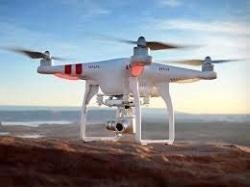Fri, Jun 27, 2014
Private Citizen Operated DJI Phantom Near Wildfire Area
The Department of the Interior has released an Interagency Aviation Safety Alert related to the operation of UAVs by hobbyists and other civilians.

According to the document, a private citizen launched a DJI Phantom unmanned aircraft in order to acquire video of the Two Bulls fire approximately 10 miles northwest of Bend, Oregon. "Although the aircraft remained outside of the TFR, it serves as a reminder that such flights are becoming more common due to their reduction in cost and the public’s interest in fire and natural disasters," the notice said.
"These factors pose significant potential to interfere with our mission and therefore imperative that local aviation managers (UAO/FAO) and Incident Management Teams (IMTs) attempt to mitigate this hazard," the DOI said in the document.
The agency says that UAO/FAOs and IMTs should communicate/coordinate with the local media in order to educate the affected region’s public on unmanned aircraft (UAS and model aircraft) operations and how it can pose greater risk to the incident aircraft and inhibit response efforts if aircraft are forced to divert and/or abort their missions. Local law enforcement should also be engaged so that they can act on any reports of unauthorized activity. If that occurs, notify the FAA and provide them with the LE agency and operator’s contact information so that they can follow up with the appropriate enforcement action. Last, be sure to submit a SAFECOM for tracking and trending purposes.
"Unauthorized UAS or remote controlled aircraft operations in close proximity to incidents can manifest in other unique ways as well," the document says. "Some have sought to make this a business opportunity in that individuals or businesses offer data that can be collected with these types of unmanned aircraft. This type of commercial operation is not currently authorized by the FAA, DOI or USFS. Any attempt by an individual to fly an unmanned aircraft for commercial purposes on an incident should be reported. DOI and USFS are determining the potential integration of UAS into the incident environment via a deliberative process.

"Increased unmanned aircraft activity presents hazards to ALL aviation users, including resource operations," the department continued. "Most commonly (but not exclusively), unmanned aircraft will be operating within close proximity to terrain thus increasing risk for low level resource operations. Resource operations including reconnaissance and aerial application with extremely limited reaction time usually operate without the protection a TFR provides within most incident operations. Partner organizations including states and other cooperators performing manned resource operations must also become aware of this hazard. Timely communication across jurisdictional boundaries amongst all parties through dispatch centers and partner contacts is essential to the successful mitigation of this hazard and flight safety in general.
"Authorized unmanned activity is approved by Certificate of Authorization (COA) from the FAA. This also highlights the importance of flight crews checking NOTAMS prior to flying as any approved unmanned operation will be required to have the appropriate NOTAM in place. Questions pertaining to the use of unmanned aircraft should be directed to the DOI UAS Specialist or USFS Aviation Safety Manager."
(Image from DOI Safety Alert)
More News
Very High Frequency The frequency band between 30 and 300 MHz. Portions of this band, 108 to 118 MHz, are used for certain NAVAIDs; 118 to 136 MHz are used for civil air/ground voi>[...]
Aero Linx: Aviation Suppliers Association Established February 25, 1993, the Aviation Suppliers Association (ASA), based in Washington, D.C., is a not-for-profit association, repre>[...]
Have A Story That NEEDS To Be Featured On Aero-News? Here’s How To Submit A Story To Our Team Some of the greatest new stories ANN has ever covered have been submitted by our>[...]
From 2021 (YouTube Version): Colorado Campus Offers aVariety Of Aerospace Entertainment And Education Wings over the Rockies Exploration of Flight is the second location for the Wi>[...]
Also: Paramotor Champ's, Electric Ultralight, ICON BK Update, Burt Rutan at Oshkosh! The Popular Rotorcraft Association is reaching out for help in rebuilding their private runway >[...]
 ANN's Daily Aero-Term (05.17.24): Very High Frequency
ANN's Daily Aero-Term (05.17.24): Very High Frequency ANN's Daily Aero-Linx (05.17.24)
ANN's Daily Aero-Linx (05.17.24) ANN FAQ: Submit a News Story!
ANN FAQ: Submit a News Story! Classic Aero-TV: ANN Visits Wings Over The Rockies Exploration Of Flight
Classic Aero-TV: ANN Visits Wings Over The Rockies Exploration Of Flight Airborne Affordable Flyers 05.16.24: PRA Runway, Wag-Aero Sold, Young Eagles
Airborne Affordable Flyers 05.16.24: PRA Runway, Wag-Aero Sold, Young Eagles




